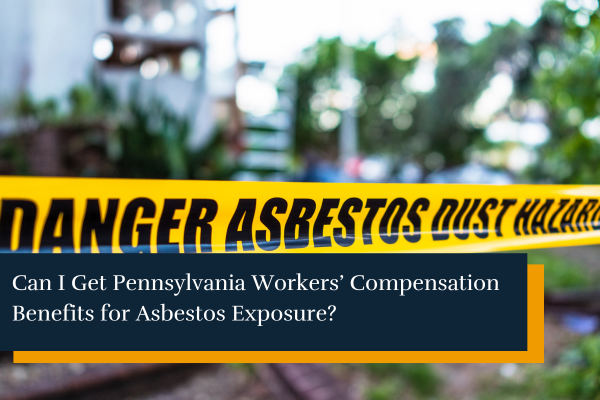
If you develop an occupational disease related to asbestos, you may be eligible for asbestos exposure compensation. While the range of illnesses and conditions varies greatly, the purpose of workers’ comp for asbestos exposure is to compensate Pennsylvania workers for the medical care required to treat their disease or condition and part of their lost wages.
What Rights Do Asbestos-Exposed Workers Have?
If you were exposed to asbestos in Pennsylvania while performing your job and developed an illness as a result, you may be entitled to asbestos compensation. Under the Pennsylvania Workers’ Compensation Act, asbestos exposure is considered an occupational disease, meaning you have longer than the typical 120-day deadline to file a workplace injury claim.
While the general time limit for filing a workers’ comp asbestos claim for an occupational disease is 300 weeks from the last date of asbestos exposure, you may still be able to pursue financial compensation even after the deadline has passed. Specifically, if a disease such as mesothelioma is discovered after the 300-week time frame has expired, you may still have other legal options for compensation. According to the official Pennsylvania government site, “For certain lung diseases, you must have worked in an occupation with a silica, coal or asbestos hazard for at least two years in Pennsylvania during the 10 years prior to your disability.”
Occupations At Risk for Asbestos Illnesses
Pennsylvania workers in certain industries are at a greater risk of developing illnesses due to prolonged exposure. Unfortunately, those workers who worked extensively with asbestos during their careers can develop mesothelioma, a disease for which there is no cure. Regardless of the type of asbestos you were exposed to, you can develop a disease or medical condition.
Workers in the following occupations are at an increased risk for asbestos-related illnesses:
- Construction workers
- Paper mill workers
- Roofers
- Power plant employees
- Plumbers
- Steel mill workers
- Shipyard workers
Common Ways Workers Are Exposed to Asbestos
Workers can be exposed to asbestos when airborne fibers are released and inhaled when building components or materials are cut, sanded, or removed. They can also ingest asbestos through contaminated clothing or skin contact. Exposure often occurs when performing work on an older building. Prolonged exposure can cause serious health conditions, including those specifically associated with asbestos: lung cancer, asbestosis, and mesothelioma.
Different Types of Asbestos
There are six unique types of asbestos, a naturally occurring silicate mineral: actinolite, tremolite, chrysotile, amosite, anthophyllite, and crocidolite. Chrysotile, amosite, and crocidolite were the most common types of asbestos used. Each form of asbestos is extremely dangerous if ingested or inhaled.
What was asbestos used for? It had several purposes and was contained in many products to increase their durability and resistance to heat and corrosion. For example, asbestos was used in building insulation, roofing shingles, vinyl flooring, fireproof materials, and car brakes.
Contact Our Workers’ Compensation Lawyers Today
At Calhoon & Kaminsky, P.C., we understand how scared you feel after experiencing asbestos exposure on the job. The possible medical conditions and diseases you could suffer are severe and vary greatly. You can trust us to work hard to ensure you receive the compensation for asbestos exposure you deserve while walking you through the workers’ comp process. We offer free case evaluations, so contact us today to learn how we can help you.
This post was originally published in July 2016 and has been updated for accuracy and comprehensiveness in February 2025.
- About the Author
- Latest Posts
Mr. Kaminsky was raised in Towanda, a small town in Northeastern Pennsylvania, where his parents instilled in him traditional values of hard work and caring for your community. This is reflected in his dedication to protecting injured workers’ rights and ensuring Employers take responsibility for their employee’s injuries.



